Exercise 7.2 - Chapter 7 Financial Mathematics 11th Business Maths Guide Samacheer Kalvi Solutions - SaraNextGen [2024-2025]
Updated By SaraNextGen
On April 24, 2024, 11:35 AM
Exercise 7.2
Text Book Back Questions and Answers
Question 1.
Find the market value of 62 shares available at 132 having the par value of 100.
Solution:
Market value = Number of shares × Market value of a share
= 132 × 62
= 8,184
Question 2.
How much will be required to buy 125 of 25 shares at a discount of 7.
Solution:
Face value of a share = 25
Market value of a share = 25 – 7 = 18
Amount of money required to buy 125 shares = Number of shares × Market value of a share
= 125 × 18
= 2,250
Question 3.
If the dividend received from 9% of 20 shares is 1,620, find the number of shares.
Solution:
Income = Number of shares × Face value of a share × Rate of dividend
1620 = Number of shares 

Question 4.
Mohan invested 29,040 in 15% of 100 shares of a company quoted at a premium of 20%. Calculate
(i) the number of shares bought by Mohan
(ii) his annual income from shares
(iii) the percentage return on his investment
Solution:
Investment = 29,040
Rate of dividend = 15%
Number of shares = 100
Premium = 20%
(i) Number of shares
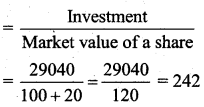
(ii) Annual income from shares = (Number of shares) × (Face value of a share) × (Rate of dividend)
= 242 × 100 × 15100
= 3630
(iii) The percentage return on his investment
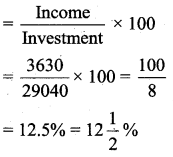
Question 5.
A man buys 400 of 10 shares at a premium of 2.50 on each share. If the rate of dividend is 12% find
(i) his investment
(ii) annual dividend received by him
(iii) rate of interest received by him on his money
Solution:
(i) Given Number of shares = 400
Face value of a share 10 market values of a share = 10 + 2.50 = 12.50
Investment = Number of shares × Market value of a share = 400 × 12.50 = 5000
(ii) Annual dividend = Number of shares × Face value × Rate of dividend

=480
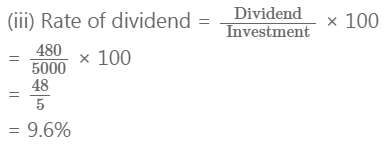
Question 6.
Sundar bought 4,500 of 10 shares, paying 2% per annum. He sold them when the price rose to 23 and invested the proceeds in 25 shares paying 10% per annum at 18. Find the change in his income.
Solution:
Number of shares 
Income from 2% stock = Number of shares × face value × Rate of dividend

= 575
Income, from 10% stock = No of shares × face value × Rate of dividend

= 1437.5
= 1437.50
Charge in his income = 1437.50 – 90 = 1347.50
Question 7.
A man invests 13,500 partly in 6% of 100 shares at 140 and partly in 5% of 100 shares at 125. If his total income is 560, how much has he invested in each?
Solution:
Let the amount invested in 6% of 100 shares at 140 be x.
Then the amount invested in 5% of 100 shares at 125 is 13500 – x.
Income from 6% shares = Number of shares × Face value of a share × Rate of dividend

Income from 5% shares = Number of shares × Face value of a share × Rate of dividend

Given that the total income = 560
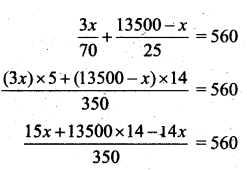
x + 13500 × 14 = 560 × 350
x = 196000 – 189000 = 7000
Amount invested at 6% stock = 7,000
Amount invested at 5% stock = 13500 – 7000 = 6500
Question 8.
Babu sold some 100 Shares at a 10% discount and invested his sales proceeds in 15% of 50 shares at 33. Had he sold his shares at a 10% premium instead of a 10% discount, he would have earned 450 more. Find the number of shares sold by him.
Solution:
Let the number of shares sold by Babu be x.
The face value of a share is 100.
He sold a 10% discount; the selling price of one share 90.
The selling price of x shares = 90x
He bought a share of face value 50 and the number of shares 33.
∴ Number of shares bought for the amount

∴ Face value of 50 shares = Cost of one share × Number of share
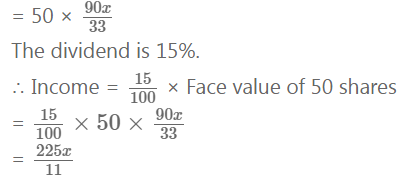
Suppose he sold his shares at 10% premium instead of 10% discount, the market value of one share is 110.
Selling price of x shares 
Number of shares bought for 

Change Income = 450
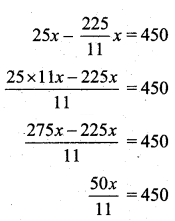

Question 9
Which is better investment? 7% of 100 shares at 120 (or) 8% of 100 shares at 135.
Solution:
Let the investment in each case be (120 × 135)
Case (i): Income from 7% of 100 shares at 120 
= 7 × 135
= 945
Case (ii): Income from 8% of 100 shares at 135 
= 8 × 120
= 960
∴ 8% of 100 shares at 135 is better investment.
Question 10.
Which is better investment? 20% stock at 140 (or) 10% stock at 70.
Solution:
Let the investment in case be 140 × 70
Income from 20% stock at 140 is 
= 20 × 70
= 1400
Income from 10% stock at 70  = 1400
= 1400
For the same investtnent both stocks fetch the same income. Therefore they are equivalent shares.
Also Read : Exercise-7.3-Chapter-7-Financial-Mathematics-11th-Business-Maths-Guide-Samacheer-Kalvi-Solutions
